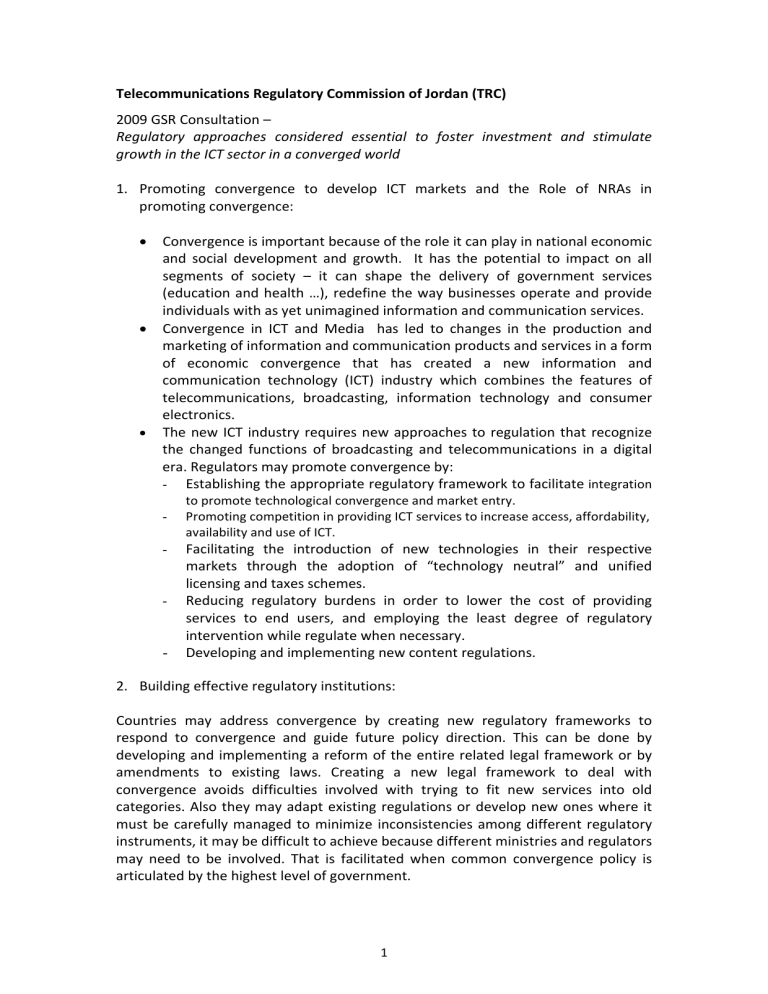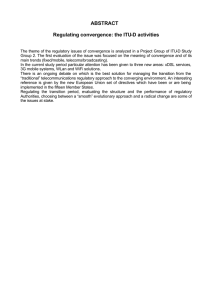Telecommunications Regulatory Commission of Jordan (TRC) 2009 GSR Consultation – Regulatory approaches considered essential to foster investment and stimulate growth in the ICT sector in a converged world
advertisement

Telecommunications Regulatory Commission of Jordan (TRC) 2009 GSR Consultation – Regulatory approaches considered essential to foster investment and stimulate growth in the ICT sector in a converged world 1. Promoting convergence to develop ICT markets and the Role of NRAs in promoting convergence: • • • Convergence is important because of the role it can play in national economic and social development and growth. It has the potential to impact on all segments of society – it can shape the delivery of government services (education and health …), redefine the way businesses operate and provide individuals with as yet unimagined information and communication services. Convergence in ICT and Media has led to changes in the production and marketing of information and communication products and services in a form of economic convergence that has created a new information and communication technology (ICT) industry which combines the features of telecommunications, broadcasting, information technology and consumer electronics. The new ICT industry requires new approaches to regulation that recognize the changed functions of broadcasting and telecommunications in a digital era. Regulators may promote convergence by: - Establishing the appropriate regulatory framework to facilitate integration - - - to promote technological convergence and market entry. Promoting competition in providing ICT services to increase access, affordability, availability and use of ICT. Facilitating the introduction of new technologies in their respective markets through the adoption of “technology neutral” and unified licensing and taxes schemes. Reducing regulatory burdens in order to lower the cost of providing services to end users, and employing the least degree of regulatory intervention while regulate when necessary. Developing and implementing new content regulations. 2. Building effective regulatory institutions: Countries may address convergence by creating new regulatory frameworks to respond to convergence and guide future policy direction. This can be done by developing and implementing a reform of the entire related legal framework or by amendments to existing laws. Creating a new legal framework to deal with convergence avoids difficulties involved with trying to fit new services into old categories. Also they may adapt existing regulations or develop new ones where it must be carefully managed to minimize inconsistencies among different regulatory instruments, it may be difficult to achieve because different ministries and regulators may need to be involved. That is facilitated when common convergence policy is articulated by the highest level of government. 1 From our point of view, building a new converged regulator is better than depending on the cooperation amongst sector specific regulators, where in case of converged regulator the duplication of regulatory work will be minimized and the Regulator’s administration cost will be decreased due to the merge of multiple institutions in one converged regulator. The merged regulator helps in fastening the business processes. In addition to the ability to receive the applications and complaints related to ICT and Media in one place. 3. Using regulatory tools to stimulate investment in a converged world: Handling the following regulatory issues emerging from the convergence of services and technologies: • Pricing (Emerging products may be using different pricing schemes) • Interconnection (interconnection between new services and platforms) • Licensing (Coordination Consistency between regulation of content services and broadcasting licensing) • Universal Service (A definition of USO which only includes voice becomes less relevant as voice is delivered in combination with a host of other services) • Spectrum Management (adapt new techniques of spectrum management to promote development of new applications) 4. Stimulating growth in innovative applications and devices towards connecting the unconnected. • The merging of delivery platforms and content creates new opportunities for the development and delivery of services and products that can expand access to communications services in all parts of the world and better meet the needs of users. There is a need for the innovations that will flow from adaptation to convergence to expand network coverage and provide appropriate services to meet constantly evolving user needs. • One of the main aspects of convergence is that different services can be transmitted within different networks. This can be used to extend the penetration of basic communication services. For example, cable TV networks can be used to offer telephony and Internet services. • In many countries mobile communication is seen as a replacement for fixed telephony. The development of new generations of mobile networks can be utilized to offer mobile Internet, mobile TV, and other advanced services. This is important for the provision of ‘convergence services’ in developing countries as the penetration of PCs is low. • In many countries the broadcast frequencies are under‐utilized. Establishing digital TV networks in these countries will give the providers the possibility to go beyond the traditional broadcast services. • Furthermore, the technological development that enables using power line communications (PLC) is interesting, as communication services can be offered without the need for laying new wires to cover the last‐mile. In many countries the power lines are extended to the residential areas. And if not so, the combination of delivery of electricity and communication services will give new incentives for this development. 2






